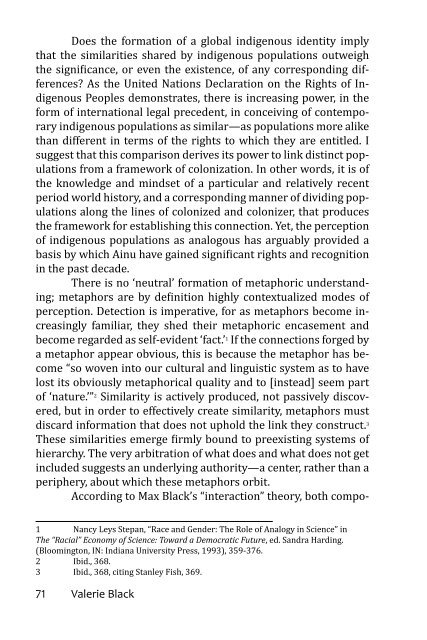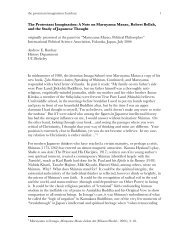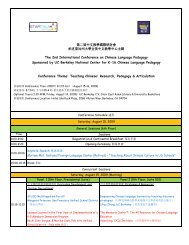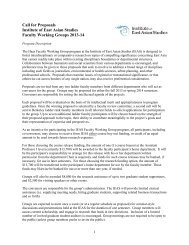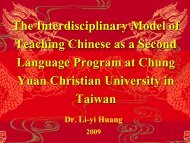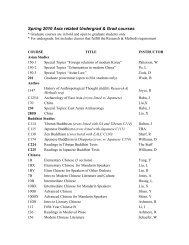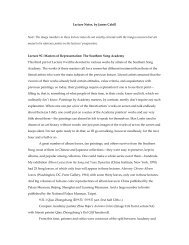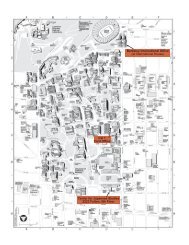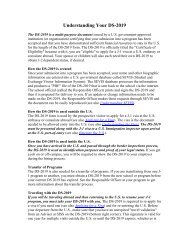Third Edition Spring 2013 - Institute of East Asian Studies, UC ...
Third Edition Spring 2013 - Institute of East Asian Studies, UC ...
Third Edition Spring 2013 - Institute of East Asian Studies, UC ...
You also want an ePaper? Increase the reach of your titles
YUMPU automatically turns print PDFs into web optimized ePapers that Google loves.
Does the formation <strong>of</strong> a global indigenous identity implythat the similarities shared by indigenous populations outweighthe significance, or even the existence, <strong>of</strong> any corresponding differences?As the United Nations Declaration on the Rights <strong>of</strong> IndigenousPeoples demonstrates, there is increasing power, in theform <strong>of</strong> international legal precedent, in conceiving <strong>of</strong> contemporaryindigenous populations as similar—as populations more alikethan different in terms <strong>of</strong> the rights to which they are entitled. Isuggest that this comparison derives its power to link distinct populationsfrom a framework <strong>of</strong> colonization. In other words, it is <strong>of</strong>the knowledge and mindset <strong>of</strong> a particular and relatively recentperiod world history, and a corresponding manner <strong>of</strong> dividing populationsalong the lines <strong>of</strong> colonized and colonizer, that producesthe framework for establishing this connection. Yet, the perception<strong>of</strong> indigenous populations as analogous has arguably provided abasis by which Ainu have gained significant rights and recognitionin the past decade.There is no ‘neutral’ formation <strong>of</strong> metaphoric understanding;metaphors are by definition highly contextualized modes <strong>of</strong>perception. Detection is imperative, for as metaphors become increasinglyfamiliar, they shed their metaphoric encasement andbecome regarded as self-evident ‘fact.’ 1 If the connections forged bya metaphor appear obvious, this is because the metaphor has become“so woven into our cultural and linguistic system as to havelost its obviously metaphorical quality and to [instead] seem part<strong>of</strong> ‘nature.’” 2 Similarity is actively produced, not passively discovered,but in order to effectively create similarity, metaphors mustdiscard information that does not uphold the link they construct. 3These similarities emerge firmly bound to preexisting systems <strong>of</strong>hierarchy. The very arbitration <strong>of</strong> what does and what does not getincluded suggests an underlying authority—a center, rather than aperiphery, about which these metaphors orbit.According to Max Black’s “interaction” theory, both compo-1 Nancy Leys Stepan, “Race and Gender: The Role <strong>of</strong> Analogy in Science” inThe “Racial” Economy <strong>of</strong> Science: Toward a Democratic Future, ed. Sandra Harding.(Bloomington, IN: Indiana University Press, 1993), 359-376.2 Ibid., 368.3 Ibid., 368, citing Stanley Fish, 369.71 Valerie Blacknents <strong>of</strong> a metaphor are transformed by their interaction, and renderedmore alike. 4 Indigeneity, when understood as a metaphoricinteraction, implies stagnant and timeless human populations locatedin an exalted pre-colonized past that is forever beyond reclamation.Indigenous groups are symbolically bound to conceptions<strong>of</strong> time and place, even long after land and other resource accesshas been systematically appropriated from them. A metaphoricunderpinning accounts for the ways in which indigenous identitiesare collectivized and condensed—impacting, in turn, how legalrights, and thus recognition, take shape.The question <strong>of</strong> whether Ainu are ‘more’ indigenous thanWajin has been long disputed in Japan—Ainu were not <strong>of</strong>ficiallyrecognized as an indigenous population by the Japanese governmentuntil 2008. To speak <strong>of</strong> Ainu and Japanese as discrete categoriessuggest that Ainu are not Japanese, and excludes those <strong>of</strong>mixed heritage. Yet to call ‘ethnic’ Japanese ‘Wajin’ upholds theidea that there is an ethnically ‘pure’ form <strong>of</strong> Japanese identity. Togain legal and political leverage, indigenous populations, and thusindividuals, must fall neatly into contemporary national borders,and exist in the context <strong>of</strong> a nation-state. When an Ainu leaves Hokkaid<strong>of</strong>or Los Angeles, or for Tokyo for that matter, does this diminishthe source <strong>of</strong> power behind a collective indigenous identity? 5Should Ainu rights in Japan follow an international model, and besituated first and foremost in indigenous identity? How might perceptions,including self-perceptions, <strong>of</strong> indigenous groups be impactedby unexamined metaphoric relationships? The metaphor<strong>of</strong> indigeneity does not operate exclusively to the detriment <strong>of</strong> thepopulations it symbolically links. By examining the role <strong>of</strong> metaphorin constructing and reconstructing Ainu identities, and establishingthe relationship between these identities and Ainu history,science, law, and bodies, I seek to show the potency <strong>of</strong> metaphor inshaping, as opposed to merely reflecting, reality.4 Max Black, “More About Metaphor” in Metaphor and Thought, ed. AndrewOrtony. (New York: Cambridge University Press, 1979), 19-43.For a discussion <strong>of</strong> M. Black’s interactive theory metaphor in relation to the production<strong>of</strong> scientific knowledge, see: Stepan, “Race and Gender: The Role <strong>of</strong> Analogy in Science,”359-376.5 Mark L. Watson, “Diasporic Indigeneity: Place and the Articulation <strong>of</strong> AinuIdentity in Tokyo, Japan,” Environment and Planning A42:2 (2010): 268-284.Ainu Indigeneity 72


